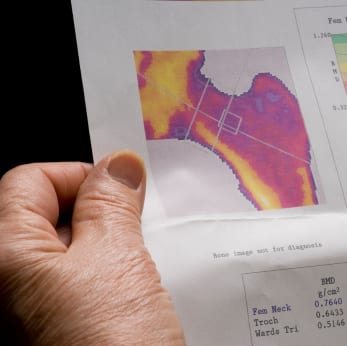
Our bones are amazing structures, capable of supporting tremendous force through complex motions. They do this day in and day out, year after year as we sit, stand, walk, run, lift, work, and play. But as the elderly among us know all too well, bones are not invincible and become more fragile as we age. As the natural, continuous cycle of bone turnover slows down and becomes unbalanced, bone is broken down faster than it is replaced — and important bone-strengthening minerals like calcium are lost.
Low bone mineral density (BMD) is one of the hallmarks of osteoporosis (literally “porous bones”), a disease that impacts nearly 45 million people in US and is responsible for more than one million fractures each year. Women develop osteoporosis much more frequently than men, especially after menopause. The burden on the health care system is significant and is expected to double over the next 10-15 years as the population ages.
Although it is natural to lose bone mass as we get older, genetic factors are known to play a large role in determining bone mass and the rate at which bone mineral density decreases. The relationship between genetics and BMD is complex, and association studies have implicated many different genes that may play a role. New research published this week in Nature Genetics continues the search for genetic factors and has identified more than a dozen SNPs associated with BMD in Europeans.
The team of researchers, led by Fernando Rivadeneira and Andre Uitterlinden of the Erasmus Medical Center in The Netherlands, used data from the Genetic Factors for Osteoporosis (GEFOS) Consortium containing lumbar spine BMD and femoral neck BMD measurements for almost 20,000 individuals. About half of the variants they identified replicated previously reported genetic associations with BMD, but the other half were new.
Some of the SNPs were associated with lower BMD while others were associated with higher BMD. For instance, individuals with one or more copies of the C allele at one of the SNPs tended to have lower lumbar spine BMD than those without, and individuals with one or more copies of the C allele at another SNP tended to have higher lumbar and femoral neck BMD.
The exact biological processes affected by these variants are still unclear, but increasing evidence points to several signaling pathways known to be important in bone biology.
One of these pathways is mediated by the “Wnt” family of proteins; Wnt signaling is important both for proper differentiation of cells responsible for breaking down bone and for the development of cartilage, required for new bone formation. , for instance, is near the gene that encodes β-catenin, an important node through which Wnt proteins influence cellular processes such as gene expression (this SNP is not on 23andMe’s platform but correlates perfectly with one that is, ). Wnt proteins can also act through other channels potentially affected by additional SNPs identified by this study.
Another pathway implicated by the growing body of research is estrogen signaling. There is no doubt that the drop in estrogen following menopause in women leads to increased risk for osteoporosis, and hormone replacement therapy can have a protective effect. Not surprisingly, estrogen affects numerous biological processes – including bone maintenance – mainly through its role in gene expression. Variants in ESR1, the major estrogen receptor found in bone, have been associated with BMD and osteoporosis, though results are far from conclusive. Rivadeneira and colleagues confirmed the association of a SNP in ESR1, , with lumbar spine BMD. Several other SNPs are also located in or near genes that may influence the regulation of bone development.
Osteoporosis is the most common bone disorder in developed countries. One in two women and one in four men over the age of 50 will experience a bone fracture due to the disease. Diets rich in calcium (especially before your mid-30s) and regular exercise can help combat bone loss. Meanwhile, the search carries on for clues that could lead to greater understanding of bone disease and potential avenues for treatment.



